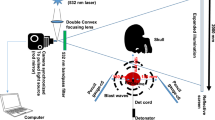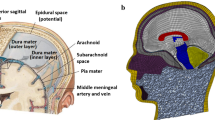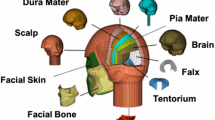Abstract
Intracranial pressure (ICP) during the interaction between blast wave and the head is a crucial evaluation criterion for blast-induced traumatic brain injury (bTBI). ICP variation is mainly induced by the blast wave transmission and skull deformation. However, how the skull deformation influences the ICP remains unclear, which is meaningful for mitigating bTBI. In this study, both experimental and numerical models are developed to elucidate the effect of skull deformation on ICP variation. Firstly, we performed the shock tube experiment of the high-fidelity surrogate head to measure the ICP, the blast overpressure, and the skull surface strain of specific positions. The results show that the ICP profiles of all measured points show oscillations with positive and negative change, and the variation is consistent with the skull surface strain. Further numerical analysis reveals that when the blast wave reaches the measured point, the peak overpressure transmits directly through the skull to the brain, forming the local positive ICP peak, and the impulse induces the local inward deformation of the skull. As the peak overpressure passes through, the blast impulse impacts the nearby skull supported by the soft and incompressible brain tissue and extrudes the skull outward in the initial position. The inward and outward skull deformation leads to the oscillation of ICP. These numerical analyses agree with experimental results, which explain the appearance of negative and positive ICP peaks and the synchronization of negative ICP with surface strain. The study has implications for medical injury diagnosis and protective equipment design.








Similar content being viewed by others
References
Anderson, J. D., Jr. Fundamentals of Aerodynamics. New York: Tata McGraw-Hill Education, 2010
Bass, C. R., M. B. Panzer, K. A. Rafaels, G. Wood, J. Shridharani, and B. Capehart. Brain injuries from blast. Ann. Biomed. Eng. 40:185–202, 2012
Bolander, R., B. Mathie, C. Bir, D. Ritzel, and P. VandeVord. Skull flexure as a contributing factor in the mechanism of injury in the rat when exposed to a shock wave. Ann. Biomed. Eng. 39:2550–2559, 2011
Bull, A. M., J. Clasper, and P. F. Mahoney. Blast Injury Science and Engineering. Switzerland: Springer, 2016
Carlsen, R. W., A. L. Fawzi, Y. Wan, H. Kesari, and C. Franck. A quantitative relationship between rotational head kinematics and brain tissue strain from a 2-D parametric finite element analysis. Brain Multiphys.2:100024, 2021
Chafi, M., G. Karami, and M. Ziejewski. Biomechanical assessment of brain dynamic responses due to blast pressure waves. Ann. Biomed. Eng. 38:490–504, 2010
Chavko, M., W. A. Koller, W. K. Prusaczyk, and R. M. McCarron. Measurement of blast wave by a miniature fiber optic pressure transducer in the rat brain. J. Neurosci. Methods. 159:277–281, 2007
Clemedson, C. J. Shock wave transmission to the central nervous system. Acta Physiol. Scand. 37:204–214, 1956
Clemedson, C. J., and H. Pettersson. Propagation of a high explosive air shock wave through different parts of an animal body. Am. J. Physiol.-Legacy Content. 184:119–126, 1955
Courtney, A., and M. Courtney. The complexity of biomechanics causing primary blast-induced traumatic brain injury: a review of potential mechanisms. Front. Neurol. 6:221, 2015
Courtney, E. C., A. Courtney, and M. Courtney. Shock tube design for high intensity blast waves for laboratory testing of armor and combat materiel. Defence Technol. 10:245–250, 2014
Crowley, J. S., F. T. Brozoski, S. M. Duma, and E. A. Kennedy. Development of the facial and ocular countermeasures safety (FOCUS) headform. Aviat. Space Environ. Med. 80:831, 2009
Dal Cengio Leonardi, A., N. J. Keane, K. Hay, A. G. Ryan, C. A. Bir, and P. J. VandeVord. Methodology and evaluation of intracranial pressure response in rats exposed to complex shock waves. Ann. Biomed. Eng. 41:2488–2500, 2013
Defense and V. B. I. Center. DoD Worldwide Numbers for Traumatic Brain Injury. Washington, DC: Defense and Veterans Brain Injury Cent, 2011
Estrada, J. B., H. C. Cramer III., M. T. Scimone, S. Buyukozturk, and C. Franck. Neural cell injury pathology due to high-rate mechanical loading. Brain Multiphys.2:100034, 2021
Falland-Cheung, L., J. N. Waddell, K. C. Li, D. Tong, and P. Brunton. Investigation of the elastic modulus, tensile and flexural strength of five skull simulant materials for impact testing of a forensic skin/skull/brain model. J. Mech. Behav. Biomed. Mater. 68:303–307, 2017
Feng, K., L. Zhang, X. Jin, C. Chen, S. Kallakuri, T. Saif, J. Cavanaugh, and A. King. Biomechanical responses of the brain in swine subject to free-field blasts. Front. Neurol. 7:179, 2016
Fievisohn, E., Z. Bailey, A. Guettler, and P. VandeVord. Primary blast brain injury mechanisms: current knowledge, limitations, and future directions. J. Biomech. Eng.140:020806, 2018
Foster, J. K., J. O. Kortge, and M. J. Wolanin. Hybrid III—a biomechanically-based crash test dummy. SAE Trans. 1977. https://doi.org/10.4271/770938
Ganpule, S., A. Alai, E. Plougonven, and N. Chandra. Mechanics of blast loading on the head models in the study of traumatic brain injury using experimental and computational approaches. Biomech. Model. Mechanobiol. 12:511–531, 2013
Ganpule, S., N. P. Daphalapurkar, K. T. Ramesh, A. K. Knutsen, D. L. Pham, P. V. Bayly, and J. L. Prince. A three-dimensional computational human head model that captures live human brain dynamics. J. Neurotrauma. 34:2154–2166, 2017
Ganpule, S., L. Gu, A. Alai, and N. Chandra. Role of helmet in the mechanics of shock wave propagation under blast loading conditions. Comput. Methods Biomech. Biomed. Eng. 15:1233–1244, 2012
Ganpule, S., R. Salzar, B. Perry, and N. Chandra. Role of helmets in blast mitigation: insights from experiments on PMHS surrogate. Int. J. Exp. Comput. Biomech. 4:13–31, 2016
Garimella, H. T., R. H. Kraft, and A. J. Przekwas. Do blast induced skull flexures result in axonal deformation? PLoS ONE.13:e0190881, 2018
Goldstein, L., A. Fisher, C. Tagge, X. Zhang, L. Velisek, J. Sullivan, C. Upreti, J. Kracht, M. Ericsson, and M. Wojnarowicz. Chronic traumatic encephalopathy in blast-exposed military veterans and a blast neurotrauma mouse model. Sci. Transl. Med. 4:134ra160, 2012
Griffin, M., B. Leung, Y. Premakumar, M. Szarko, and P. Butler. Comparison of the mechanical properties of different skin sites for auricular and nasal reconstruction. J. Otolaryngol.-Head Neck Surg. 46:1–6, 2017
Gunko, V. M., I. N. Savina, and S. V. Mikhalovsky. Properties of water bound in hydrogels. Gels. 3:37, 2017
Gupta, R. K., and A. Przekwas. Mathematical models of blast-induced TBI: current status, challenges, and prospects. Front. Neurol. 4:59, 2013
Gupta, R. K., X. G. Tan, M. R. Somayaji, and A. J. Przekwas. Multiscale modelling of blast-induced TBI mechanobiology-from body to neuron to molecule. Defence Life Sci. J. 2:3–13, 2017
Hua, Y., P. Kumar Akula, L. Gu, J. Berg, and C. A. Nelson. Experimental and numerical investigation of the mechanism of blast wave transmission through a surrogate head. J. Comput. Nonlinear Dyn. 9:1031010, 2014
Iwaskiw, A., K. Ott, R. Armiger, A. Wickwire, V. Alphonse, L. Voo, C. Carneal, and A. Merkle. The measurement of intracranial pressure and brain displacement due to short-duration dynamic overpressure loading. Shock Waves. 28:63–83, 2018
Kong, L.-Z., R.-L. Zhang, S.-H. Hu, and J.-B. Lai. Military traumatic brain injury: a challenge straddling neurology and psychiatry. Militar. Med. Res. 9:1–18, 2022
Lei, J., Z. Zhou, and Z. Liu. Side chains and the insufficient lubrication of water in polyacrylamide hydrogel—a new insight. Polymers. 11:1845, 2019
Leonardi, A. D. C., C. A. Bir, D. V. Ritzel, and P. J. VandeVord. Intracranial pressure increases during exposure to a shock wave. J. Neurotrauma. 28:85–94, 2011
Li, J., W. Li, X. Hong, J. Yu, and J. Zhu. Blast wave characteristics of multi-layer composite charge: Theoretical analysis, numerical simulation, and experimental validation. Defence Technol. 2021. https://doi.org/10.1016/j.dt.2021.11.012
Li, J., T. Ma, C. Huang, X. Huang, Y. Kang, Z. Long, and M. Liu. Protective mechanism of helmet under far-field shock wave. Int. J. Impact Eng.143:103617, 2020
Liu, Y., X. Qiu, H. Ma, W. Fu, and T. Yu. A study of woodpecker’s pecking process and the impact response of its brain. Int. J. Impact Eng. 108:263–271, 2017
Logsdon, A. F., B. P. Lucke-Wold, R. C. Turner, J. D. Huber, C. L. Rosen, and J. W. Simpkins. Role of microvascular disruption in brain damage from traumatic brain injury. Compr. Physiol. 5:1147, 2015
Lu, J., K. C. Ng, G. Ling, J. Wu, D. J. F. Poon, E. M. Kan, M. H. Tan, Y. J. Wu, P. Li, and S. Moochhala. Effect of blast exposure on the brain structure and cognition in Macaca fascicularis. J. Neurotrauma. 29:1434–1454, 2012
Maas, A. I., D. K. Menon, P. D. Adelson, N. Andelic, M. J. Bell, A. Belli, P. Bragge, A. Brazinova, A. Büki, and R. M. Chesnut. Traumatic brain injury: integrated approaches to improve prevention, clinical care, and research. The Lancet Neurol. 16:987–1048, 2017
Mao, H., G. Unnikrishnan, V. Rakesh, and J. Reifman. Untangling the effect of head acceleration on brain responses to blast waves. J. Biomech. Eng.137:124502, 2015
Moss, W. C., M. J. King, and E. G. Blackman. Skull flexure from blast waves: a mechanism for brain injury with implications for helmet design. Phys. Rev. Lett.103:108702, 2009
Nie, X., B. Sanborn, T. Weerasooriya, and W. Chen. High-rate bulk and shear responses of bovine brain tissue. Int. J. Impact Eng. 53:56–61, 2013
Oros-Peusquens, A.-M., R. Loução, Z. Abbas, V. Gras, M. Zimmermann, and N. Shah. A single-scan, rapid whole-brain protocol for quantitative water content mapping with neurobiological implications. Front. Neurol. 2019. https://doi.org/10.3389/fneur.2019.01333
Ouellet, S., C. Bir, and A. Bouamoul. Direct Comparison of the Primary Blast Response of a Physical Head Model with Post-Mortem Human Subjects. Ottawa: Defence Research and Development Canada-Valcartier Research Center Quebec, 2014
Ouellet, S., and M. Philippens. The multi-modal responses of a physical head model subjected to various blast exposure conditions. Shock Waves. 28:19–36, 2018
Panzer, M. B., B. S. Myers, B. P. Capehart, and C. R. Bass. Development of a finite element model for blast brain injury and the effects of CSF cavitation. Ann. Biomed. Eng. 40:1530–1544, 2012
Rahaman, M. M., W. Fang, A. L. Fawzi, Y. Wan, and H. Kesari. An accelerometer-only algorithm for determining the acceleration field of a rigid body, with application in studying the mechanics of mild traumatic brain injury. J. Mech. Phys. Solids.143:104014, 2020
Roberts, J., T. Harrigan, E. Ward, T. Taylor, M. Annett, and A. Merkle. Human head–neck computational model for assessing blast injury. J. Biomech. 45:2899–2906, 2012
Salzar, R. S., D. Treichler, A. Wardlaw, G. Weiss, and J. Goeller. Experimental investigation of cavitation as a possible damage mechanism in blast-induced traumatic brain injury in post-mortem human subject heads. J. Neurotrauma. 34:1589–1602, 2017
Selvan, V., S. Ganpule, N. Kleinschmit, and N. Chandra. Blast wave loading pathways in heterogeneous material systems–experimental and numerical approaches. J. Biomech. Eng.135:061002, 2013
Singh, D., and D. Cronin. Multi-scale modeling of head kinematics and brain tissue response to blast exposure. Ann. Biomed. Eng. 47:1993–2004, 2019
Skotak, M., F. Wang, A. Alai, A. Holmberg, S. Harris, R. C. Switzer, and N. Chandra. Rat injury model under controlled field-relevant primary blast conditions: acute response to a wide range of peak overpressures. J. Neurotrauma. 30:1147–1160, 2013
Sundar, S., and A. Ponnalagu. Biomechanical analysis of head subjected to blast waves and the role of combat protective headgear under blast loading: a review. J. Biomech. Eng.143:100801, 2021
Sutar, S., and S. Ganpule. Investigation of wave propagation through head layers with focus on understanding blast wave transmission. Biomech. Model. Mechanobiol. 19:875–892, 2020
Tse, K. M., S. P. Lim, V. B. C. Tan, and H. P. Lee. A review of head injury and finite element head models. Am. J. Eng. Technol. Soc. 1:28–52, 2014
Vogel, E. W. Pathobiological Mechanisms and Treatment of Electrophysiological Dysfunction Following Primary Blast-Induced Traumatic Brain Injury. New York: Columbia University, 2017
Wang, Z., A. A. Volinsky, and N. D. Gallant. Crosslinking effect on polydimethylsiloxane elastic modulus measured by custom-built compression instrument. J. Appl. Polym. Sci. 131:41050, 2014
Yang, C., T. Yin, and Z. Suo. Polyacrylamide hydrogels. I. Network imperfection. J. Mech. Phys. Solids. 131:43–55, 2019
Zhang, J., F. A. Pintar, N. Yoganandan, T. A. Gennarelli, and S. F. Son. Experimental study of blast-induced traumatic brain injury using a physical head model. Stapp Car Crash J. 53:215–227, 2009
Zhu, F., C. C. Chou, K. H. Yang, and A. I. King. A theoretical analysis of stress wave propagation in the head under primary blast loading. Proc. Inst. Mech. Eng. Part H. 228:439–445, 2014
Zhu, F., C. Wagner, A. Dal Cengio Leonardi, X. Jin, P. VandeVord, C. Chou, K. H. Yang, and A. I. King. Using a gel/plastic surrogate to study the biomechanical response of the head under air shock loading: a combined experimental and numerical investigation. Biomech. Model. Mechanobiol. 11:341–353, 2012
Acknowledgments
This work is supported by the Science Challenge Project, No. TZ2018002, National Natural Science Foundation of China, under Grant Nos. 11972205, 11921002 and 11972210, the National Key Research Development Program of China (No. 2020-JCJQ-ZD-254).
Conflict of interest
No benefits in any form have been or will be received from a commercial party related directly or indirectly to the subject of this manuscript.
Author information
Authors and Affiliations
Corresponding author
Additional information
Associate Editor Jillian Urban oversaw the review of this article.
Publisher's Note
Springer Nature remains neutral with regard to jurisdictional claims in published maps and institutional affiliations.
Supplementary Information
Below is the link to the electronic supplementary material.
Rights and permissions
About this article
Cite this article
Du, Z., Li, Z., Wang, P. et al. Revealing the Effect of Skull Deformation on Intracranial Pressure Variation During the Direct Interaction Between Blast Wave and Surrogate Head. Ann Biomed Eng 50, 1038–1052 (2022). https://doi.org/10.1007/s10439-022-02982-5
Received:
Accepted:
Published:
Issue Date:
DOI: https://doi.org/10.1007/s10439-022-02982-5




